#louise de kerouaille
Explore tagged Tumblr posts
Text
I'm like Louise de Kerouaille in that I am very much prone to crying.
#louise de kerouaille duchess of portsmouth#the fact she cried as well makes me feel better#i'm not the only one#restoration
1 note
·
View note
Note
since you clearly know your history, do you think aegon iv's situation with his mistresses while he was king was handled realistically? weren't official king's mistresses married off before taking on their positions because any bastard children sired needed a legal father? falena was married off but there's no mention of barba, melissa, or the other women after aegon iv ascended having husbands. i mean, obviously barba needed to be unwed so she could have a chance of becoming queen but if melissa wanted to establish herself as a non-grasping replacement, shouldn't she go get a husband so naerys, aemon, and daeron couldn't feel threatened? and even if melissa was a super nice person, how she could she remain "well-loved" at court while publicly having bastards and one of them is an albino? wouldn't her reputation be ruined if aegon iv dropped her and she remained unmarried after that?
I think the historical record is somewhat mixed on that point. Think of, for example, GRRM’s, ugh, favorite point of reference for Aegon IV, Henry VIII (yeah, I know): Bessie Blount was not married at the time she was in a relationship with the king (and conceived Henry Fitzroy with him), though she did marry after her son’s birth, while it’s entirely unclear when Mary Boleyn married relative to when she and Henry VIII had their relationship (and, of course, Henry offered to make Anne Boleyn his mistress while she was unmarried). Likewise, if we look to Charles II - another inspiration, I think, for Aegon IV, no less so because I tend to think he named Barba Bracken after Charles’ long-term mistress Barbara Villiers, Duchess of Cleveland - the record is far from one-sided: Barbara herself, for example, was married during their relationship of course, but the king’s two primary mistresses at the end of his life, Louise de Kerouaille and Nell Gwynn, were both unmarried for the whole of their lives (and as much as James Scott, Duke of Monmouth, Charles’ eldest extramarital son, might have claimed that Charles had married his mother, Lucy Walter, when the two were exiles in the Netherlands, Charles himself vehemently denied the supposed marriage, which had no evidence of its existence otherwise). Too, Louis XIV - not perhaps explicitly cited by GRRM as an inspiration for Aegon the Unworthy, but certainly a king famous for his love affairs - had both married and unmarried mistresses: while Louise de La Vallière was unmarried (and later ended her life as a repentant nun), the Marquise de Montespan did have a husband (who notoriously held a “funeral” for his wife after she became the king’s mistress); the widower King Louis did, almost certainly, end up marrying his last mistress, the similarly widowed Marquise de Maintenon. (There is also the story that when one of Louis’ early loves, Marie de Mancini, married her eventual husband, Prince Colonna, the prince was surprised to discover that his wife was a virgin, as he said he had not expected to find “innocence among the loves of kings”.) Again, these are only a very few, very limited examples, but I think it’s fair enough to say that GRRM could have felt, let’s say somewhat historically comforted by having Aegon IV’s mistresses be (mostly) unmarried women.
In any event, I don’t think it was a necessity that Melissa Blackwood be married in order for her to be seen as unthreatening to the queen. While the details of Melissa’s life, especially her time as Aegon’s mistress, are frustratingly thin and vague based on our current knowledge, it does seem that Melissa went out of her way to curry favor with Queen Naerys, Prince Daeron, and Prince Aemon - a step that Barba Bracken almost certainly never took, if she was looking to replace Naerys as queen (and perhaps have her son Aegor replace Daeron as heir). It is also worth pointing out, of course, that in the aftermath of Barba’s, and probably more generally Lord Bracken’s and his faction’s, failed attempt to have Barba marry the king, Melissa and whatever faction was supporting her may have emphasized that Melissa had no such ambitions in order to distinguish her from the disgraced former mistress. Additionally, the fact that Melissa did not have a son with the king until a few years after their relationship began may have also served as some reassurance to the queen, Prince Daeron, and Prince Aemon: not only, perhaps, did Melissa appear not to want to replace the queen, but she had no ready would-be heir, as Barba had had, to promote in place of Daeron and strengthen her ambition to create a new royal family.
Naturally, because we know nothing about why Melissa was sent away from court, or what happened to her after, we have no idea how her brief years as the king’s chief mistress affected her life or her socio-political prospects thereafter. I do tend to think that Melissa didn’t live a long life after leaving court, though when and how she might have died is obviously completely unclear. In any event, though, I could see where Melissa’s positive reputation, especially if she died relatively young, might have been preserved at court: the kind-hearted, widely beloved young woman, perhaps driven from the court by those no-good-very-bad Brackens who had then replaced her with a “faithless” mistress. Once King Daeron II came to the throne himself, the new king may have been even more inclined to think fondly of the woman who had treated himself and his late mother and uncle with respect and deference, where few if any other of his father’s mistresses had - “better this mistress than any other”, perhaps, to paraphrase the Queen of France on the subject of her husband’s beloved mistress, Madame de Pompadour. (Naturally as well, once Bloodraven came into power and influence, especially after the First Blackfyre Rebellion, he would likely have done much to promote the positive legend of his mother, especially in contrast to the surviving reputation of Barba Bracken - a legacy that I think will be central to the conflict of “The Village Hero”).
It’s also worth pointing out that while King Aegon’s identified chief mistresses after his ascension seem to have been unmarried young women, this is not to say that the king probably limited his sexual liaisons during his reign only to these individuals. After all, Yandel notes in his overview of Daeron II’s reign that during Aegon IV’s rule, the men of the City Watch of King’s Landing whom the king promoted “made sure that the brothels—and even the decent women of the city—were available for Aegon’s lusts”; I think it’s probably fair to say Yandel likely included “married” in his definition of “decent”. Moreover, while Yandel identified Jeyne Lothston as Aegon IV’s chief mistress after the downfall of Bethany Bracken, the maester-author also suggested that the king “enjoyed mother and daughter together in the same bed”, after Falena Lothston (nee Stokeworth) brought young Jeyne to court (a disturbing rumor, of course, when paired with the additional suggestion by Yandel that Jeyne had been fathered by the king, not Lord Lucas). I fully expect that when we learn more about Aegon IV’s reign (especially given the, ugh, high likelihood of even more unnecessary sexual exploits to be highlighted in Fire and Blood Volume 2), Aegon’s omnivorous sexual desire, including for married women, will be underlined.
49 notes
·
View notes
Text

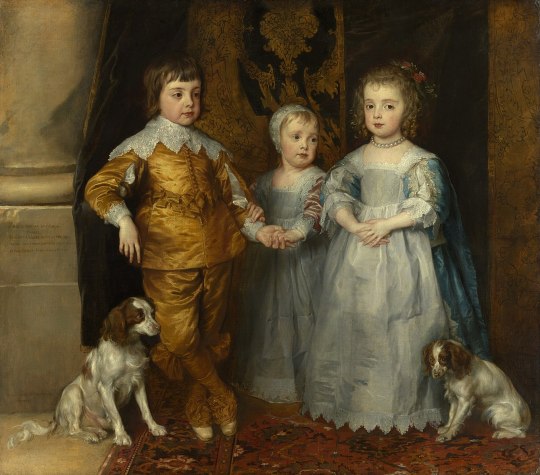
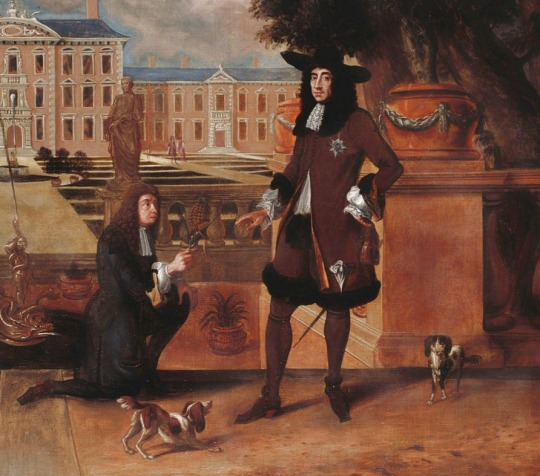
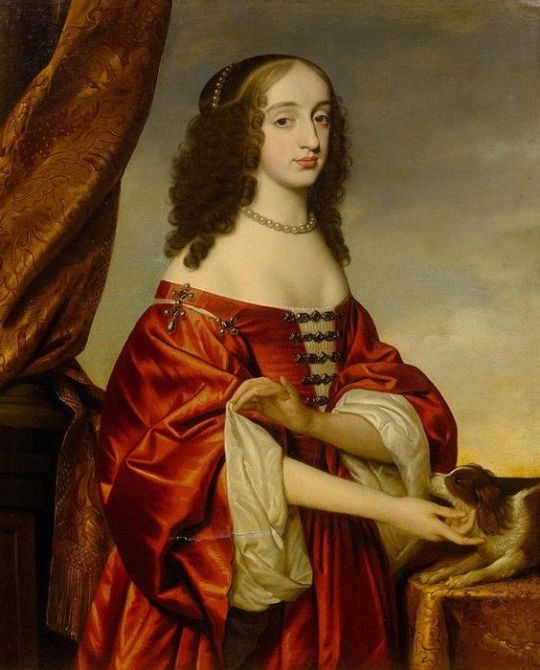
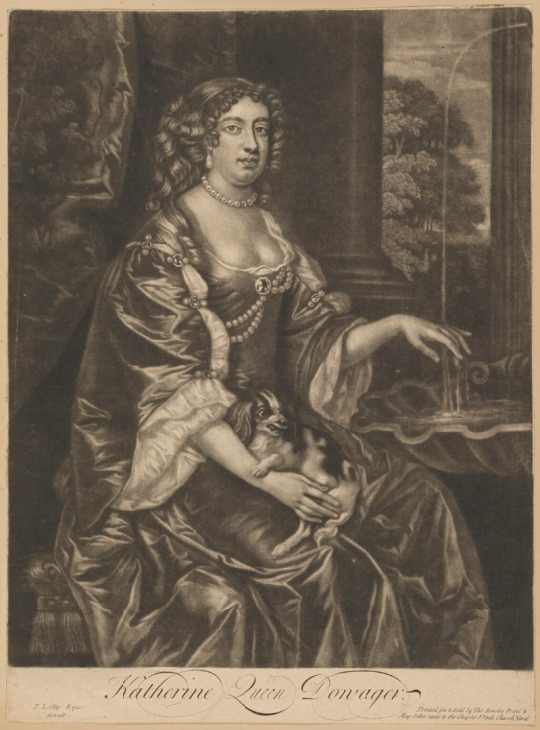
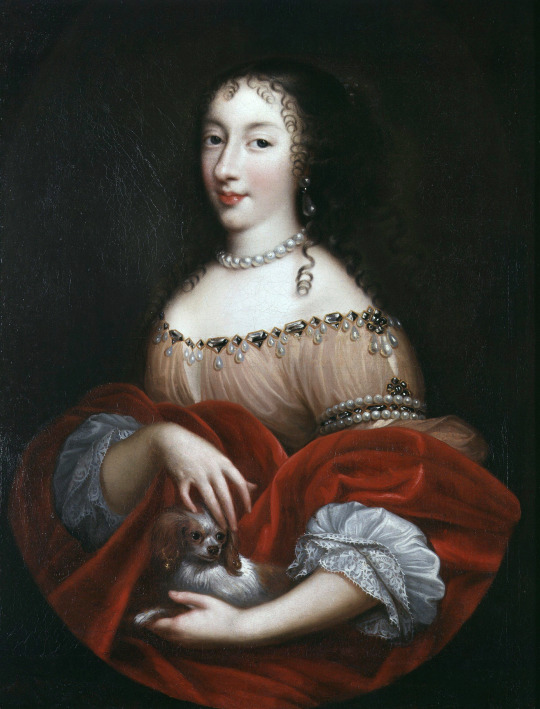
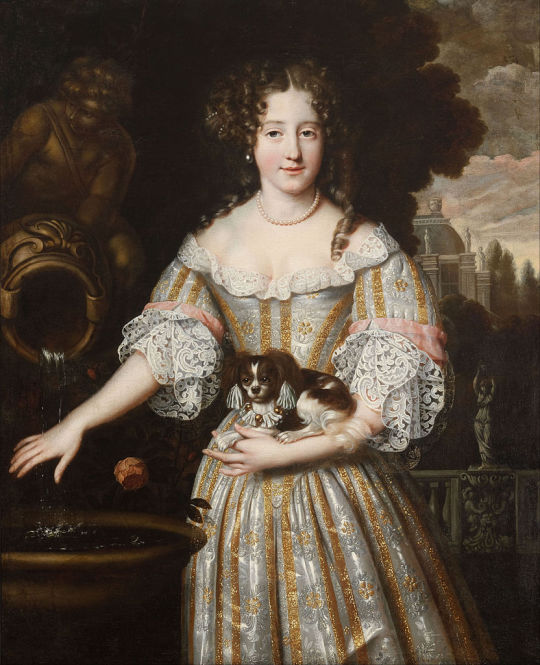
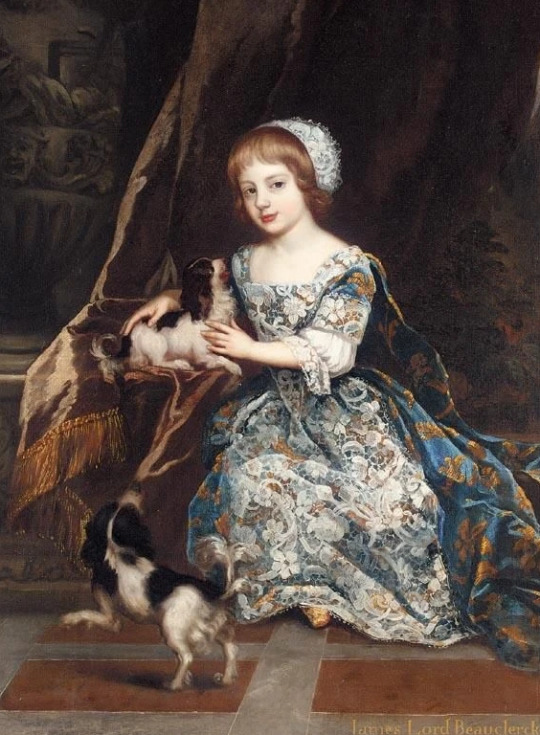

I stayed and heard Alderman Barker’s case of his being abused by the Council of Ireland, touching his lands there; all I observed there is the silliness of the King, playing with his dog all the while, and not minding the business... --Diary of Samuel Pepys, 4 September 1667
Portraits of Charles II and his family with the dogs that would come to be called Cavalier King Charles Spaniels after him
In order: Charles as an infant; Charles with his sister Mary and brother James; Charles as king; his sister Mary; his wife Catherine of Braganza; his sister Henrietta; his mistress Louise de Kerouaille; James Beauclerk, his youngest son by Nell Gwyn; his nephew James, Prince of Wales
#doggos#stuarts#portraiture#Imma guess they painted the Jameses there with the dogs to emphasize their connections to Charles#Maybe Catherine too#but at least Beauclerk's dogs are happy to be there#Catherine and Francis Edward's dogs are having a straight-up bad time#omg Henrietta's dog is wearing lil hoop earrings#Catherine and Louise both have their hands in streams of water which symbolizes something or other I forget
37 notes
·
View notes
Text
Today I bring you yet another idea for a musical: a Six-like musical about the mistresses of Charles II. Nell Gwyn sings a very theatrical Broadway-like song. Barbara Palmer's song it's basically Bad guy, but sung with angry energy. Louise de Kerouaille sings a French pop song with weird lyrics no one actually gets but it's a bop.
#Somebody steal this idea and make it happen#History#But make it a musical#Nell Gwyn#Barbara Villiers#Louise de Kerouaille#Charles II#Also tagging#Six the musical#Because that's the inspiration for this hypothetical musical
29 notes
·
View notes
Photo

Willem Wissing (b.1656-d.1687), ‘Portrait of a Lady, with a Page’, 1600s, Dutch-English, oil on canvas, for sale est. 40,000-60,000 GBP in Christie’s Visions of Collecting sale, September 2019.
The frame’s inscription bears the following attribution: ‘SIR PETER LELY 1618-1680/THE DUCHESS OF PORTSMOUTH 1649-1734/COLLECTION: GOULDBURN’; referring to the painter Peter Lely, and Louise de Kerouaille, Duchess of Portsmouth, mistress of Charles II.
#i mean if the attribution to willem wissing is correct there's a good chance there's an etching of this no?#willem wissing#unknown sitter#known artist#1600s#oil on canvas#dutch#english#christies#louise de kerouaille#peter lely
29 notes
·
View notes
Text
weep and wail and weep some more until the king, your lover, eventually pays off your gambling debts
#louise de kerouaille#she did this and consequently#nell gwynn nicknamed her 'the weeping willow'#and apparently she used to cry loudly
125 notes
·
View notes
Photo
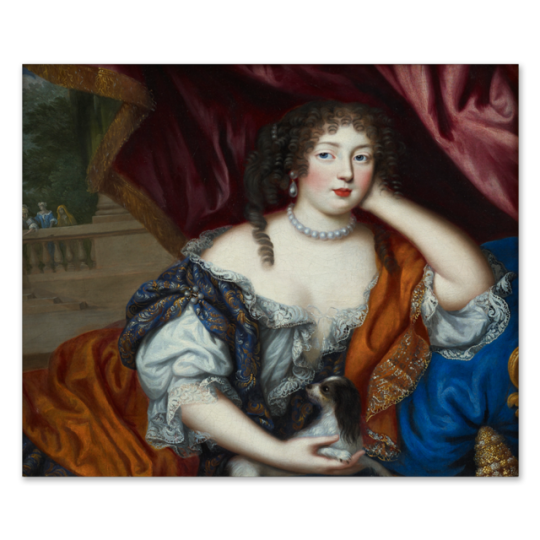
Portrait of Louise Renée de Penancoët de Kérouaille, Duchess of Portsmouth (1649-1734) // painted by Henri Gascars
Louise de Kérouaille was one of the favourite mistresses of King Charles II of England. She initially met Charles when she accompanied his sister, Henriette d’Orléans, on her diplomatic visit to England from France in 1670. On the side, Louise was probably acting as a spy for King Louis XIV of France but she became a beloved companion of King Charles II and she was one of the three women he mentioned on his deathbed. Charles nicknamed her ‘Fubs’ (and named one of his yachts, HMS Fubs, after her), a 17th century word and term of endearment that means plump or chubby.
Source
34 notes
·
View notes
Photo

Louise de Kérouaille, Duchess of Portsmouth (September 1649 - 14 November 1734)
#louise de kerouaille#louise renee de penancoet de kerouaille#duchess of portsmouth#daughter of guillaume de kerouaille#mistress of charles ii of england#history#women in history#17th century#18th century#art
34 notes
·
View notes
Photo

THE MISTRESS
Louise de Penancoët de Kérouaille, Duchess of Portsmouth (1649-1734) Mistress of King Charles II of England
#the mstress#louise de penacoet de kerouaille#duchess of portsmouth#uk#british nobility#british aristocracy#united kingdom#great britain#england#royal#royals#royalty#royaltyedit
8 notes
·
View notes
Text
Dramatis personae:
Hortense, duchess of Mazarin Armand-Charles, her husband Marie, her sister Philippe-Jules, her brother Charles II, king of England Anne Lennard, countess of Sussex
From https://partylike1660.com/hortense-mancini-duchesse-mazarin/
In January 1666, as Hortense had just given birth to Paul Jules and was eager to rejoin court life, her husband took all her jewellery from her while she was dressing and forbade her to leave. Hortense, in tears, thus tried to flee to the neighbouring property of her brother Philippe-Jules, Duc de Nevers, but her husband had the connection door in the garden closed up with bricks. What followed was witnessed by many happening to pass by. Hortense fled to the street to reach the property of her brother, under the cries of her husband urging the servants to take her captive. Hortense was once again locked up in a cloister, but freed with the help of her brothers-in-law and Armand-Charles banished from the Palais Mazarin.
Hortense finally made a bid to escape from her hellish marriage on the night of 13 June 1668, with help from her brother. Disguised in men’s clothing and on horseback, she left Paris in the midst of the night and boarded a carriage at its outskirts, that brought her to Lorraine and from there to Rome, to her sister Marie, now Princesse Colonna. Philippe-Jules joined them there shortly after and the exiled Chevalier de Lorraine as well. The latter had an eye on Hortense, but she had no particular interest in him and thus turned him down.
Hortense returned to France in 1670* and that in a not less scandalous manner. This time it was Marie fleeing from her abusive husband, afraid he might plan to poison her. Philippe-Jules asked for permission to bring both her and Hortense to France with him. Louis XIV declared himself protector of both sisters and the plan went underway. Marie and Hortense left Rome, wearing men’s garments under their travelling garments. They went to Monaco, where a boat, chartered by their brother, was waiting for them. The voyage was delayed by Hortense giving birth to a child obviously not from her husband, which lead him thus to spread rumours of a incestual relationship between Hortense and Jules-Philippe. Louis XIV intervened again and ordered Armand-Charles to refrain from stating accusations like this, then granted Hortense an annual pension of 24000 livres. Her former suitor the Duc de Savoy also declared himself her protector and Hortense retired to Chambéry, in Haute-Savoie, where she establish her home as a meeting place for authors, philosophers, and artists.
After the death of her Savoyan protector in 1675, Hortense had no source of income anymore, since her husband froze all of her income, including the pension from Louis XIV. The English ambassador to France, Ralph Montagu, aware of Hortense’s desperate situation, enlisted her help in increasing his own standing with Charles II. He hoped she would replace the King’s current mistress, Louise de Kerouaille, Duchess of Portsmouth. Hortense was willed to try and disguised herself as a man again to travel to England, under the pretext of a visit to her young niece, Mary of Modena, the new wife of Charles’ younger brother, James, Duke of York.
It did not take long until the plan succeeded. Already by mid 1675, Hortense was a visitor of Charles’ bed and he provided her with a pension of £4,000, enabling her to live a comfortable life.
From https://en.wikipedia.org/wiki/Hortense_Mancini:
This state of affairs might have continued had it not been for Hortense's promiscuity. She was dubbed 'the Italian Whore' in England.
Firstly, there was her almost certainly sexual relationship with Anne, Countess of Sussex, the king's illegitimate daughter by the Duchess of Cleveland. This culminated in a very public, friendly fencing match in St. James's Park, with the women clad in nightgowns, after which Anne's husband ordered his wife to the country. There she refused to do anything but lie in bed, repeatedly kissing a miniature of Hortense
#*I think this date is wrong? I'm reading Madame de Sévigné's letters#and the letter where she refers to this event is dated 1972... 🤔#mazarinettes#hortense mancini#queue cutie
14 notes
·
View notes
Note
Have to be honest, I would probably ask GRRM something historically nerdy too! On the Barba Bracken/Barbara Villiers comparison, who do you think Aegon IV's other mistresses are modeled on? I have a head-canon in which Missy Rivers is modeled on Louise de Keroualle.
Melissa Blackwood is definitely partly inspired by Louise in my mind (as well as the strangely tolerant relationship between Queen Marie Leczinska and Madame du Pompadour, which led the Queen to comment that if the king had to take a mistress, Madame du Pompadour was better than any other). This may seem strange, given that she was never a royal mistress, but I do also see some comparisons to Jane Seymour, Henry VIII’s third wife. Barba, of course, shares traits with Anne Boleyn - both dark-haired, vivacious, openly ambitious former royal lady companions who attracted a king’s attention - so her successor might well fall into the Jane Seymour role already. On top of that, though, Melissa, like Jane, was far more modest than her predecessor. When, for example, in early 1536 (while he was still married to Anne) Henry sent Jane a love letter and a purse of gold, Jane refused the obvious bribe to become his mistress; instead, she returned the pursue and unopened letter and begged the courtier who brought them to remind the King that she had no greater treasure than her honor, and that she would rather have the King send her a gift of money when God sent her a husband to marry (a not so subtle move on her own part, of course). Jane could not have the same amiable relationship with the Queen that Melissa had (given that she was herself queen), but Jane had been, like Anne Boleyn, a lady in Queen Katherine of Aragon’s household, and indeed modeled her behavior on that Queen she admired and worked to secure Henry and Katherine’s daughter Mary’s rightful place in the succession. And, just as Jane would be remembered (by Henry) as the best and best-loved of his wives, so Melissa has come to be regarded by history (at least by Yandel) as the best-loved of Aegon’s mistresses.
The most obvious parallel among any of Aegon’s mistresses - indeed, possibly the most blatant historical parallel in ASOIAF - is Bethany Bracken, a very clear version of Catherine Howard. As Bethany was the sister of a previous mistress of Aegon, Catherine Howard was a close relative of a previous wife of Henry VIII: her father was an elder brother of Anne Boleyn’s mother, making her Anne’s first cousin. As Barba and Lord Bracken groomed Bethany to replace Melissa Blackwood, so the Duke of Norfolk (Catherine’s Howard uncle) found Catherine a place at court and guided her in responding to the King’s affections (doubtless to see Howard influence restored, lost to the Seymours during Henry’s marriage to Jane and now to Cromwell, whose project the King’s marriage to Anne of Cleves had been). As Bethany was young and Aegon turned obese and disgusting, so Catherine was young (somewhere between 15 and 17 when she married the King) and Henry far from the good-looking athletic monarch who had taken the throne decades prior (a jousting accident in 1536 had left him with a permanently festering leg wound and possible lingering brain damage). Obviously, Bethany’s affair with the handsome Kingsguard knight Terrence Toyne mimics Catherine’s affair with Thomas Culpeper, a popular gentleman of the privy chamber and one of Henry’s favorite courtiers; likewise, Bethany’s and Terrence’s executions parallel Catherine’s and Culpeper’s deaths (interestingly, while Culpeper, as a gentleman and former favorite, received a sentence of simple beheading, Catherine’s alleged premarital lover Francis Dereham received the full sentence of hanging, drawing and quartering, which might make him a better parallel to the tortured Toyne; both men, however, had their heads displayed on London Bridge).
#history#Melissa blackwood#Bethany bracken#historical parallels#real world inspiration#mistresses of aegon iv#louise de kerouaille#jane seymour#catherine howard
26 notes
·
View notes
Note
what do you think Charles II and Louise de Kerouaille's relationship was like? Did she actually care about him (and vice versa) or was she just using him for her own agenda?
I think Charles loved her (he loved all his mistresses for boy was a Simp) but Louise was likely less in love. She only agreed to take the job due to French pressure and she was never interested in the physical side of things, she liked the jewels but never seemed to care for Charles as much. I mean, she left England within years of his death while other mistresses mourned him for their lives.
6 notes
·
View notes
Text

Catherine Braganza
A portrait from the Studio of Jacob Huysmans, ca. 1670, baroque
Catherine of Braganza (23.04.1638-06.02.1705) was the daughter of John, the 8th Duke of Braganza (King John IV of Portugal) and Luisa de Guzman. She had a happy childhood and had a good education but due to the fact that her mother sheltered her enourmously, contemporaries said that she 'was bred hugely retired'.
She married Charles I. of England at age 23. Their marriage was far from perfect, as it was more than clear that Charles loved his mistresses more than her. Even though he was a philanderer, every time she miscarried he was kind and did not tolerate any slander towards her.
Even if the british subjects were wary of her in the beginning, the shy, quiet and loyal Catherine soon became very popular. She abhorred Barbara Palmer (a mistress) but liked Louise de Kerouaille (the next mistress) because she showed respect and deference.
In 1678 there was the 'Popish' plot, a plot that had the goal to remove her from court and have Charles I. divorce her. That did not happen because most people in the nobility were very fond of her. She lived through William and Mary's reign and returned to Portugal, where she died at age 67 in Bemposta Castle in Lisbon.
#catherine braganza#baroque#baroque art#jacob huysmans#17th century#charles i#william of orange#mary ii#women in history#women in art#lisbon#british monarchy#portugal#portrait
11 notes
·
View notes
Note
Bastard birth would certainly not deter any given individual from making a splendid match with a member of the nobility. In the same way that the position of the king’s mistress could be highly sought after, even though a king would also be expected to have an official royal consort, so a king’s bastard could be considered a more than acceptable marital match, even though the king would (presumably) be expected to have trueborn children too.
For one, it would not be unusual for a king to shower his illegitimate offspring with wealth and titles. Charles II was very generous with his many bastard children: his eldest son James Fitzroy (later James Scott) was made Duke of Monmouth and later Duke of Buccleuch (upon his marriage to the heiress of the last Earl of Buccleuch), another son was made Earl of Plymouth, his three sons by Barbara Palmer were all made dukes (the eldest succeeding his mother as Duke of Cleveland, the second being created Duke of Grafton, and the third being made Duke of Northumberland), and each of his surviving sons by Nell Gwynn and Louise de Kerouaille were given ducal titles as well (the Duke of St. Alban and the Duke of Richmond, respectively). Louis XIV manipulated his first cousin, la Grande Mademoiselle, into surrendering two important pieces of her immense personal fortune - the county of Eu and the sovereign principality of Dombes - to his favorite bastard son, Louis-Auguste, Duke of Maine, in return for the release of her former lover and would-be husband, the duc de Lauzun. Nor would illegitimate daughters be left out: when Philippe, only son and heir of Louis XIV’s younger brother, the Duke of Orleans, was of an age to wed, his royal uncle encouraged him to accept his own legitimated bastard daughter, Françoise Marie de Bourbon, and sweetened the deal by giving her a dowry of two million francs and the promise of the Palais-Royal (a great royal palace in Paris) to be given permanently to the bridegroom’s family. (The king was slightly - but only relatively speaking - less generous with his elder daughter by Madame de Montespan, Louise Françoise: she married the high-ranking Prince of Condé in 1685, but Louis XIV only gave her a dowry of one million francs.) So, while illegitimately born, these individuals could, through the generosity of their royal parents, have noble titles and incomes in their own right.
Even more that personal wealth, illegitimate royal offspring could represent a direct road to royal power. Depending on how much a king doted on his illegitimate offspring - and that could be quite a bit - any family married to one could have a permanently assured place at court, and a direct line to the ear of the monarch. William IV of Great Britain was certainly one of the doting kind: before his accession he had 10 children with the famous actress Dorothea Jordan, and upon his becoming king gave the eldest, George Fitzclarence (a designation coming from William’s pre-kingly title of Duke of Clarence), the title Earl of Munster and the rest the style of younger children of a marquess. They and their families were a constant presence at court during William’s reign, the boys getting into violent arguments with their father about titles and incomes (having presumably inherited the spendthrift carelessness of William’s generation) as they expected to “relive the days of Charles II”, in the words of one contemporary. The Beauforts - legitimated descendants of John of Gaunt, Duke of Lancaster, and his then-mistress Katherine Swynford - also enjoyed periods of great favor, particularly from their Lancastrian kinsmen: to name a few,Joan Beaufort married the King of Scots as a symbol of an English-Scottish alliance, Cardinal Henry Beaufort was a dominating figure during the regency of the young Henry VI of England, and Edmund Beaufort was trusted as the king’s Lieutenant of France, eventually running the Lancastrian government alongside Margaret of Anjou.
Of course, illegitimately born children still having royal blood, it is perhaps unsurprising that they would be seen as useful marital prizes. Henry Fitzroy, mentioned by this Anon, was very much looked at in his time as a potential heir: as the only acknowledged son of Henry VIII until the birth of Edward VI (by which time Henry Fitzroy had died), and with the only other heir of Henry’s body being a daughter, there was a real possibility that, if Henry died with no other children, a civil war would ensue with a faction backing Henry as a male candidate (after all, the boy’s grandfather was Henry Tudor, whose only claim to the English throne came through the legitimated bastard line of the House of Beaufort). Anne Boleyn was shrewd enough to recognize this, and keen on seeing that she could count on the faction that would back Henry Fitzroy in any war over the throne (until she could herself give Henry a son, of course). Accordingly, she arranged for the marriage of Henry to Lady Mary Howard, a daughter of the Duke of Norfolk - and, importantly, Anne’s own first cousin; as she was a Howard on her mother’s side, Anne could secure her family’s influence over this potentially very important political pawn. (Unfortunately for Anne’s family hopes, Henry Fitzroy died just three years after the marriage, leaving no children.)
This is not to say, of course, that in every case members of the nobility were very pleased at marriages to royal bastards. Perhaps my favorite anecdote is of Elizabeth Charlotte of the Palatinate, Duchess of Orleans and second wife of Louis XIV’s younger brother, Philippe. When she was told that her only son was going to marry the king’s legitimized daughter, she slapped her son in full view of the entire court, and then - to the shock of everyone - turned her back on the king and walked away.
Forgive me, for I’m a bit new when it comes to learning about historical Royal and noble figures. So my question is, looking up things like the Tudor period, and other royal periods in history how were illegitimate children able to marry people of nobility? For example, Henry Fitzroy, bastard of Henry VIII, married Lady Mary Howard. But how? She was a daughter of nobility. How would her parents think it okay for Lady Mary to marry him? Would she herself feel embarrassed to marry a bastard? Etc?
I would recommend asking @goodqueenaly.
Thanks for the question, Anon.
SomethingLikeALawyer, Hand of the King
#history#warsofasoiaf#royal mistresses#charles ii of england#louis xiv of france#house of beaufort#william iv of england#henry viii of england#bastards
70 notes
·
View notes
Photo

Royal Mistresses- Louise de Kérouaille, Duchess of Portsmouth
Louise got her start as a daughter of the Seigneur de Kérouaille, an old noble family from Brittany. As the daughter of a nobleman, Louise was able to acquire a place at the court of King Louis XIV of France. When she was still quite young Louise joined the household of Princess Henrietta Anne of England, the younger sister of King Charles II and wife of the Duke of Orleans. It was hoped by her family that she would become a mistress of King Louis, but in 1670 when Louise accompanied Princess Henrietta to England she met and charmed the Princess’ brother King Charles II. When Henrietta died suddenly soon after, Louise was invited to England as a lady-in-waiting to Charles’ wife Queen Catherine.
Upon becoming the Mistress of King Charles, Louise replaced the volatile Barbara Villiers in the King’s affections. Louise was beautiful and plump, with a childlike face that prompted John Evelyn to call her “baby face.”Because of her rounder figure Charles gave her the nickname “Fubbs” (a slang term for ‘chubby’) and named a ship the HMS Fubbs in her honor. Though she was doll-like in appearance and had a sensitive nature Louise was also very clever and knew how to get what she wanted. She met with French envoys and ambassadors and was supported by King Louis in return for her support of French interests. Louise was generally disliked by the English people due to the fact that she was not only French, but Catholic as well. She was, however, well received by the Queen and the two ladies treated each other with respect and friendliness.
After the death of King Charles II, Louise fell from favor at court quickly. She returned to France with a pension granted by Louis XIV and returned to England only twice during the remainder of her life and attended the coronation of King George I. Louise died in 1734 at the old age of 85. Through her son by the King, Charles Duke of Richmond, she is a direct ancestor of Diana, Princess of Wales; Camilla, Duchess of Cornwall; and Sarah, Duchess of York.
#for the record she's my fave of Charles' mistresses#Fubbs#Louise de Kerouaille#Charles II#Louis XIV#Royal Mistresses#Stuart#17th century#art#my art#England#France
63 notes
·
View notes
Note
Why did so many women at court aspire to become the king's mistress?
For one, being the king’s mistress could be rewarding on a personal level, as kings were known to lavish great wealth on their favorites. Alice Perrers, mistress to Edward III of England, was granted robes and jewels belonging to the dead Queen Philippa (the jewels were worth over six million pounds in today’s money), as well as over a dozen manors, by her royal lover. Barbara Palmer and Louise de Kerouaille, mistresses of the lascivious Charles II, were granted dukedoms in their own right, with their requisite lands and incomes, and Barbara was given Henry VIII’s Nonsuch Palace. Louis XIV was so entranced by Athenais, the Marquise de Montespan, that he granted her a suite of 20 rooms in Versailles (compared to the queen’s 10), and had built for her the Chateau de Clagny, spending millions of livres to do so. Leopold II of Belgium shocked and angered his subjects by the wealth the aging monarch lavished on his teenage mistress, Caroline Lacroix, including millions of francs (Caroline once bragged about spending three million in a single shopping spree) and estates in Belgium and France. Even foreign visitors would know to flatter the king’s favorite: when the future Gustav III of Sweden visited the court of Louis XV, he presented the king’s mistress, the notoriously luxury-loving Madame du Barry, a collar for her little spaniel, made of diamonds and with a ruby leash.
Being the royal mistress could also be an avenue to power. Henry II of France was so devoted to his lifelong passion Diane de Poitiers that the two would often collaborate on government letters and documents, even signing the bottom “HenriDiane”. The Protestant (later Catholic) Henry IV of France relied on his beloved mistress Gabrielle d’Estrees to make peace with the noble Catholic families of the country, and it was under her influence that he created the Edict of Nantes, which gave significant rights to French Huguenots (indeed, so trusted was Gabrielle that Henry gave her a seat on his Council of National Policy). Too, as an intimate of the king, a royal mistress would be expected to have the king’s ear in private moments ordinary courtiers could never dream of sharing, and could be a useful intermediary between the king and his courtiers. Such was the power and influence of Madame de Pompadour on Louis XV that Empress Maria Theresa of Austria’s ambassador approached her for aid in the negotiations that would lead to the Treaty of Versailles and the Diplomatic Revolution that would bring Austria and France together in alliance. Prince Frederick, Duke of York and Albany and second son of George III, was not a king, but he was commander in chief of the army from 1795 - a position he was forced to resign in 1809, when his mistress, Mary Anne Clarke, was brought before the House of Commons and testified that she had, with the duke’s knowledge and assistance, been selling army commissions (even pinning the names of those desiring commissions to the curtains in the home they shared).
Nor should family ambition be discounted; having great influence over the king meant that a mistress could secure boons for her kin as well as herself. While sleeping with Mary Boleyn and thereafter pursuing sister Anne, Henry VIII granted a number of honors to the Boleyn family: Sir Thomas Boleyn (father to Mary and Anne) was made Viscount Rochford in 1525, Earl of Wiltshire in 1529, and Lord Privy Seal in 1530; their brother George was knighted and made a Gentleman of the Privy Chamber in 1529 (at which time he was also granted the courtesy title Viscount Rochford), held several key offices in Henry VIII’s court, and was made an ambassador to France, doubtless via his sister’s influence. The family of Anne, Duchess of Etampes, benefited greatly from her affair with Francis I of France, as her uncle, Antoine Sanguin, was made Bishop of Orleans and a cardinal and named Grand Almoner by Francis I when the post became vacant and two brothers also rose high in Church hierarchy. (However, when Thomas Howard, Duke of Norfolk, suggested that his daughter Mary - widow of Henry VIII’s illegitimate son, Henry Fitzroy - become the king’s mistress to wield similar influence she pointedly refused.)
And there was always the chance, however small (and however politically meaningless), that the king would make his mistress his wife. Indeed, Henry IV had come extremely close to marrying Gabrielle: in 1599, after writing to Pope Clement asking for an annulment from his marriage to Margaret of Valois, Henry gave Gabrielle his coronation ring and promised to wed her (unfortunately for Henry, she died on April 10 of that year, probably from eclampsia). Alexander II, Emperor of Russia, actually did marry his mistress, Catherine Dolgorukova, a little more than a month after his first wife, Marie of Hesse and by the Rhine, died, and gave Catherine the title Princess Yurievskaya and the status of “Serene Highness”; although the marriage was morganatic, there were fears, particularly within the imperial family, that Alexander would strive to put his children by Catherine in the succession (particularly as Catherine claimed Alexander had placed the imperial crown on her head in a private ceremony, and as Alexander had legitimized the children and made pointed comments about his son by Catherine, George Alexandrovich - commenting that George was a “real Russian” and introducing him to his heir, the future Alexander III, as George’s “eldest brother”). Louis XIV was far more secret about his marriage to Madame de Maintenon; although the marquise was never formally acknowledged as his wife, her presence at court was substantial, and for the roughly three decades their marriage lasted, Madame de Maintenon exerted far more influence over the Sun King than her predecessor, Maria Theresa, ever had.
#history#royal mistresses#alice perrers#barbara palmer#Louise de Kérouaille#athenais de montespan#madame du barry#Caroline lacroix#diane de poitiers#Gabrielle d’estrees#madame de pompadour#anne boleyn#mary boleyn#Catherine dolgorukova#madame de maintenon
748 notes
·
View notes